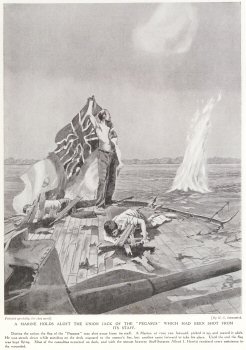This article needs additional citations for verification. (July 2015) |
| Battle of Zanzibar | |||||||
|---|---|---|---|---|---|---|---|
| Part of World War I | |||||||
 A Royal Marine, holding up the White Ensign aboard HMS Pegasus during the battle off Zanzibar. | |||||||
| |||||||
| Belligerents | |||||||
|
|
| ||||||
| Commanders and leaders | |||||||
|
|
| ||||||
| Strength | |||||||
| Light cruiser Königsberg |
Protected cruiser Pegasus Tugboat Helmuth | ||||||
| Casualties and losses | |||||||
| None |
39 killed 55 wounded Pegasus sunk Helmuth damaged | ||||||


The Battle of Zanzibar was an encounter between the German Kaiserliche Marine and the British Royal Navy early in the First World War. While taking on coal in the delta of the Rufiji River in German East Africa, the German cruiser SMS Königsberg learned that a British cruiser, HMS Pegasus, which had been part of the Royal Navy's Cape Squadron sent to counter Königsberg, had put in at Zanzibar for repairs. Königsberg's captain, Commander Max Looff, decided to attack Pegasus while she was in port.
On 20 September 1914 Königsberg sailed past the picket ship HMS Helmuth at the entrance to Zanzibar harbour. Helmuth was unable to warn Pegasus of Königsberg's approach,[why?] with the result that when Konigsberg opened fire she took Pegasus entirely by surprise. As a result, Pegasus suffered severe damage before she was even able to return fire.
Königsberg's guns out-ranged those on Pegasus, which was consequently unable to damage her opponent. The one-sided battle ended in a German victory, Pegasus sank later that day, having lost 38 crew dead.